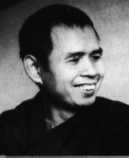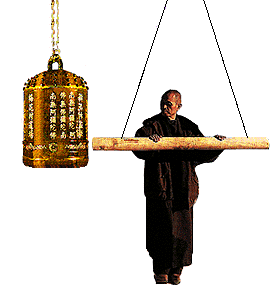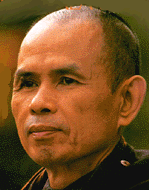Late in 1997, The Book Report on AOL featured a live chat and interview with Thich Nhat Hanh, the revered Buddhist monk, author and activist. Since Thich Nhat Hanh does not use the telephone, he had to come to the AOL Live studio. "There, with a candle burning, and a circle of interested AOL staffers surrounding him," recalled the awed interviewer Jesse Kornbluth, "TNH drank tea and, in a voice that is whisper-soft, shared his wisdom."

AOL: Good evening, all. What an honor to have Thich Nhat Hanh with us. I promise you: This won't be like any chat you've ever been to.
TNH: We invite people to sit comfortable on your chair or on your cushion, and feel there is a sangha surrounding you. From time to time, we will pause and enjoy breathing together for 20 or 30 seconds. Just pause and enjoy our breathing and feel that we are together. Just breathing and smiling.
AOL: You speak and write SO MUCH about breathing. You say: breathe mindfully at traffic lights. Breathe mindfully when the phone rings. Why such importance on breathing?
TNH: So that you can still be yourself. You establish yourself in the present moment and are totally present in the here and now, totally alive. Because we have a tendency to lose ourselves.
AOL: So many traditions not only tell us breathing is important,
they tell us how to breathe. Do you have a "method?" Or is it
more about being conscious as we breathe?
TNH: There are many methods. The method for mindful breathing is simply that you are aware of your in-breath and out-breath. Your mindful breathing might be very present. It helps bring your mind and your body back together. It produces your full presence in the here and now.
AOL: So many people think religion is HEAVY. You say: In every image, the Buddha is SMILING. Is happiness attainable for us mere mortals?
TNH: The Buddha confirmed that it is possible to live happily in the here and the now -- even if you still have lots of pain and sorrow within yourself. Mindful breathing helps you become fully alive. And when you are really there, you can touch all the wonders of life that are available in this very moment for your enjoyment...for your nourishment...and for your healing.
Question: I'm very familiar with you, and happy to see you trying such a method of communication. What got you to try it?
TNH: Arnold Kotler (my friend and publisher) and Jesse Kornbluth suggested it. And I am curious. I wanted to try it. And I'm aware that many of you are here --- and I feel wonderful.
Question: I am on the path, and I feel enlightened, but I have never "officially" received transmission from a master. How can I know or does it even matter?
TNH: If you have got enlightenment, transmission has been made in one way or another. Transmission may take place without a form.
Question: How do you deal with stress --- right on the spot, in
the stressful situation?
TNH: Go back to the here and the now, and touch the things that are positive in that moment. Your stress is only one element in the whole picture. Enjoy your breathing, and acknowledge your stress --- and then SMILE to it.
AOL: You often have said: If you want to be happy and peaceful, assume those attitudes --- even if you feel lousy. It's like choosing a channel on a TV. We decide what we want to feel, and then we feel it. Sounds too EASY!!!!
TNH: You have a seed of peace and joy in the depth of your consciousness. If you train yourself to touch these seeds within you, they will manifest themselves as energy of peace and joy. And you might get help from a co-practitioner, because he can help you touch this seed of peace and joy. If you do it every day, these seeds will grow. And it will become easier and easier to touch them, and to invite them to become positive energies in your daily life.
Question: I am a Buddhist and I strive for the goals of equanimity and unattachment as a way of freeing myself from ego. Do you think it's possible for a person to find equanimity and yet remain "IN LOVE" with his wife or lover?
TNH: True love is the capacity to offer joy and to remove afflictions in the person you love. Maitri is the capacity to offer happiness. Karuna is the capacity to transform suffering. If you know how to look deeply into the person you love, you will understand his/her situation, difficulties, sufferings and deepest aspiration. With that kind of insight, you will be able to practice both of these forms of love. And this practice goes perfectly with equanimity and freedom.
AOL: In your new book, TEACHINGS ON LOVE, you quote the Buddha: All the virtuous actions we have done are not equal to love meditation. What IS love meditation?
TNH: Love meditation is to practice looking deeply, to understand the suffering, the difficulties and aspirations of the person you love in order to offer her/him true happiness and true freedom. Your intention to love is not enough. You have to train yourself in the practice of looking deeply. Looking deeply is meditation itself.
Question: Thank you so much for sharing with us. Please suggest
the best Yoga to practice for one who is dealing with a life-threatening
illness.
TNH: I invite you to breathe with me....Let us enjoy our breathing together....[long pause] Let us continue our mindful breathing and become aware of the fact that this body is not me. I am much more than this body. The space of 50 or 60 or 70 years is not my lifespan. It is not true that I did not exist before I was born. It is not true that I will no longer exist after the disintegration of this body. My ground of being is the reality of no birth, no death. No coming, no going. It is like water is the ground of being of a wave. The wave might be afraid of being or non-being. But if she knows that she is water, she will lose all her fear. Nothing is born...nothing dies. That is a statement made by the French scientist Lavoisier. The Heart Sutra uses exactly the same terms. The day of your so-called death is truly a day of continuation. Birth and death cannot really touch us. If you know that, you will be able to enjoy every second of your daily life --- even if you are in terminal illness.
Question: How do you feel about the Internet? Is this a tool that can bring mankind toghter or divide us?
TNH: Please tell me --- you know more than I do!!!
Question: Can you comment on out-of-body experiences?
TNH: What we call body may not be just body. We usually think that "body" is something other than mind, completely different from mind. But in the deeper Buddhist picture, the same thing is manifest sometimes as body and sometimes as mind. It is like the elementary particle in nuclear physics --- sometimes it manifests itself as a wave, sometimes as a particle. And that is why scientists like to use the word "wavicle" to mean an elementary particle. In Buddhism, the word "namarupa" is very much the same. It means: both body and consciousness. So let us just use the word "experience." "Out of body" might not be apropos in the light of interbeing, body is made of mind and mind of body.
Question: Do you believe all religions are right in some sense or another?
TNH: Religions are traditions. And traditions are like trees. They must grow. Sometimes we must prune the tree in order that it not be broken --- there may be branches that are harmful to the tree. We must take care of our religious tradition to prevent it from creating obstacles for our genuine growth. We have to renew our traditions so that they can embody the true teaching and practice to fit the real needs of the younger generation. We are very much in need of tolerance...of openness...of learning mutually. Therefore our religious tradition should be able to offer opportunities for us to meet these needs.
Question: One would think that Buddha's lifestyle would make him
a thin person. Why is he so often portrayed as a fat man?
TNH: Maybe because the artist who made these statues was a fat person --- and he thought a fat person is a happy person. We need artists who can offer us statues of the Buddha that show him as smiling, happy and free --- and not too fat!
Question: In meditation what is the difference between sensation and feeling?
TNH: Sensation comes first. Feelings follow right after. Feelings are born from sensation --- but also from your previous experiences. It is important to look into the nature of your feelings. The feelings may not be the same after one or two minutes of practice. An unpleasant feeling may be transformed into a pleasant feeling --- by looking, we get some insight into its nature. A neutral feeling needs only one minute of looking deeply to be transformed into a pleasant feeling. Meditators should learn to do this for their own nourishment and transformation.
Question: I am quadraplegic. I suspect this is an opportunity for great mindfulness ---but how do I get past the fear?
TNH: You tell yourself that fear is not helpful. It is possible for you to get in touch with positive things that are there in the present moment. Use your eyes to touch something beautiful. Smile to it. And realize that there are things like that still available to you in this moment. I would like to offer a poem of 4 lines about mindful breathing:
My friends may enjoy breathing in with the first line, breathing out with the second while they do things like cooking and driving, watering the vegetables and so on.
AOL: Alas, these particular perfect moments are at an end.
TNH: I hope to meet you again.
AOL: We are honored to have had you here.
### Copyright 1997, THE BOOK REPORT, Inc. (published here by permission)
For more general information about Thich Nhat Hanh and his work: